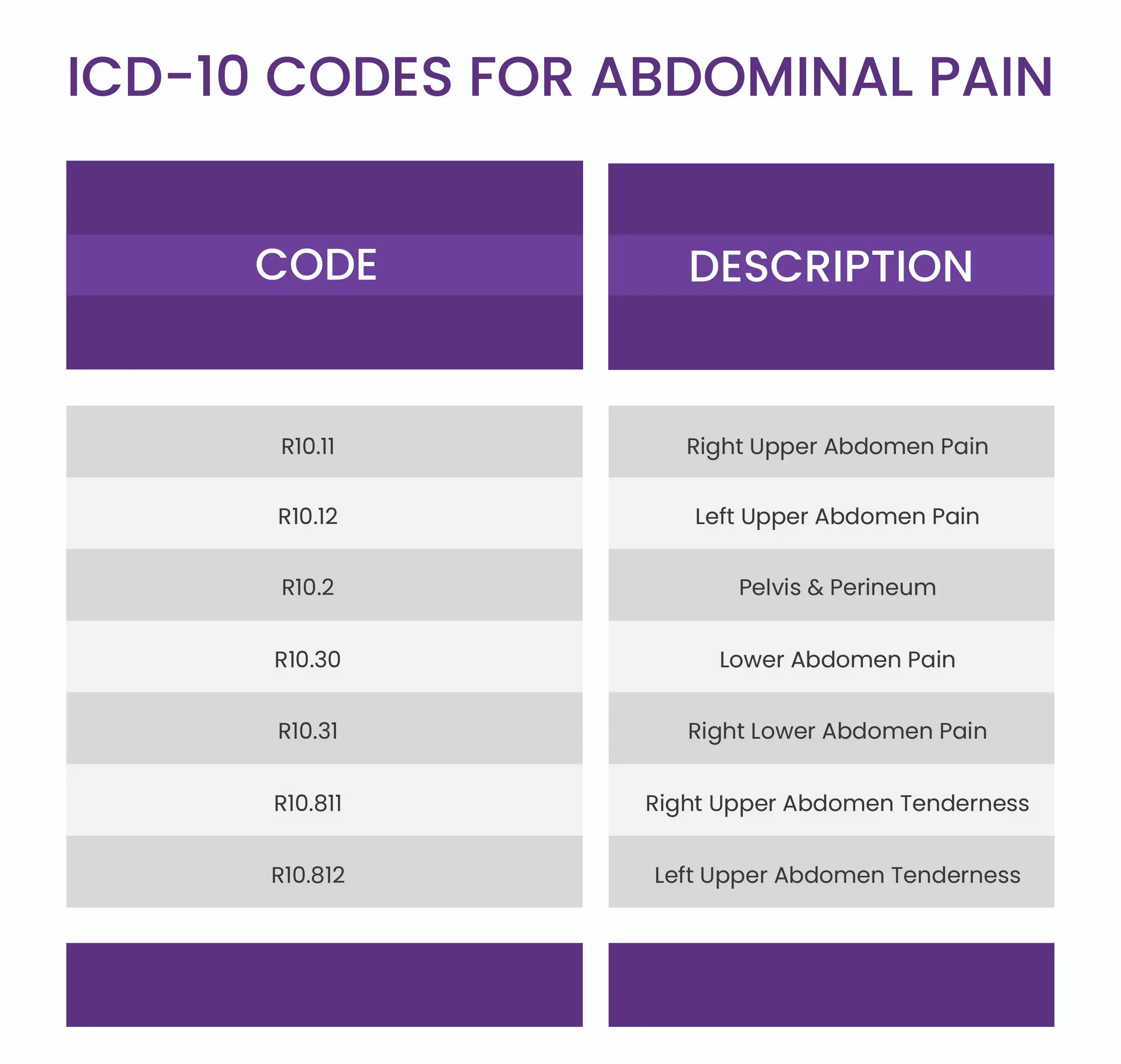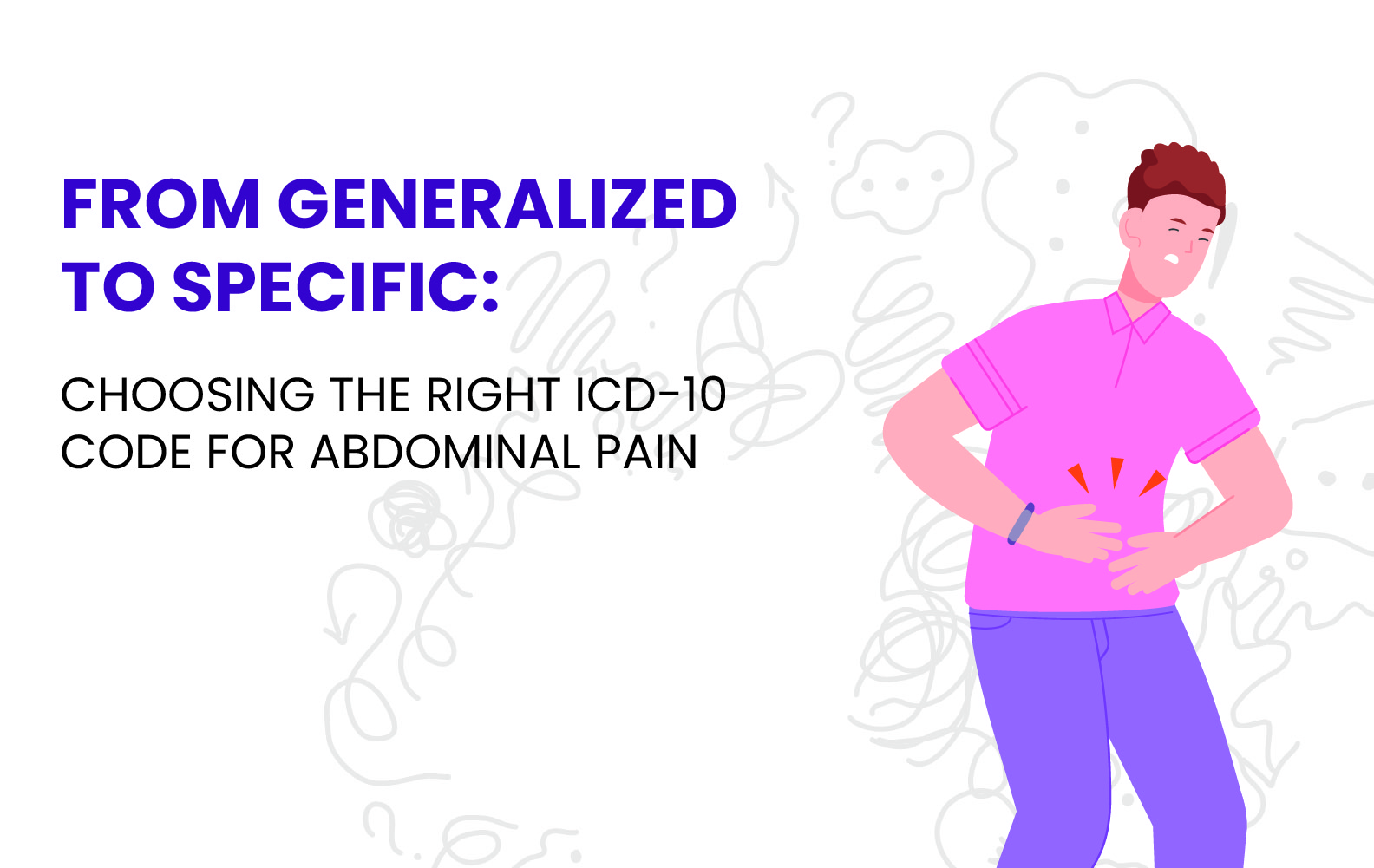Imagine this scenario: you are a gastroenterologist sitting in your office, sipping your morning coffee, when your receptionist calls in to inform you that the next patient has arrived. The patient reports abdominal pain, but you need clarification as you are unsure which code to use for billing and documentation.
This is a common dilemma that many healthcare providers face when dealing with patients who have abdominal pain. However, don't fret! This blog post will delve into the ICD-10 codes for abdominal pain and provide the information you need to document and bill your patient's care confidently. So, grab your coffee, and let's get started!
Table of Contents
Coding Requirements for abdominal Pain ICD-10
Common Symptoms of abdominal Pain
What are the most common abdominal Pain ICD-10 Codes?
Organization of ICD-10 codes for abdominal pain
Coding Requirements for Abdominal Pain ICD-10
Now that we've established the confusion that can arise when coding for abdominal pain let's dive into the requirements for ICD-10 coding. When a patient presents with abdominal pain, it's essential to accurately document the location, severity, and associated symptoms. This will help determine the appropriate code for billing and reporting purposes.
ICD-10 codes for abdominal pain are categorized by location, with specific codes for upper, lower, and generalized abdominal pain. Additional codes are available for more precise diagnoses, such as acute gastritis or colitis. Choosing the most specific code possible is essential, as this will ensure accurate reimbursement and reporting.
In addition to accurately documenting the location and severity of the pain, it's crucial to document any associated symptoms. For example, does the patient have nausea or vomiting? Is there bloating or diarrhea? These details can provide important context for the diagnosis and treatment of the patient.
Common Symptoms of Abdominal Pain
Abdominal pain is a common complaint with many causes, from minor issues like gas or indigestion to more serious conditions like appendicitis or pancreatitis. As healthcare providers, we must be aware of the common symptoms associated with abdominal pain to provide accurate diagnoses and effective treatment.
One of the most common symptoms of abdominal Pain is Pain or discomfort in the abdominal region. This can vary in severity and location, from a mild ache to a sharp, stabbing pain. Other common symptoms may include bloating, cramping, and feeling fullness or pressure in the abdomen.
What Are The Most Common Abdominal Pain ICD-10 Codes?
When it comes to coding for abdominal pain, various ICD-10 codes are available, depending on the location and severity of the pain. While choosing the most specific code possible for accurate reimbursement and reporting is essential, a few codes are more commonly used for abdominal pain. Let's take a closer look:
The most common code for generalized abdominal Pain is R10.9, which is used when the location and cause of the pain are not specified. This code can be used for mild to moderate abdominal pain not associated with other specific symptoms.
The most commonly used codes for upper abdominal Pain are K30 (dyspepsia) and R10.11 (right upper quadrant pain). These codes are used for pain in the upper abdomen, typically associated with the stomach or liver.
Lower abdominal pain is often coded as R10.31 (left lower quadrant pain) or R10.32 (right lower quadrant pain). These codes are used for pain in the lower abdomen, typically associated with the colon or reproductive organs.
Organization of ICD-10 Codes For Abdominal Pain
In the ICD-10 manual, diagnosis codes for abdominal pain are organized by the severity of the pain, with codes ranging from R10.0 (acute abdomen) to R10.9 (unspecified abdominal pain). The fourth digit of the code describes the location of the pain, with specific codes available for upper, lower, and generalized abdominal pain. The eighth digit provides additional information on the condition of the pain, including whether it is colic, generalized, or tender.
For example, suppose a patient presents with severe pain in the right lower quadrant of the abdomen. In that case, a healthcare provider may use the code R10.32 (right lower quadrant pain) to document the pain's location accurately. If the pain is also accompanied by tenderness, the code could be further specified as R10.322 (right lower quadrant pain with tenderness).
On the other hand, if a patient presents with mild generalized abdominal pain, a healthcare provider may use the code R10.84 (generalized abdominal pain) to document the location and severity of the pain accurately. If the pain is also accompanied by cramping, the code could be further specified as R10.84A (generalized abdominal pain with colic).
It's important to note that accurately coding for abdominal pain requires careful documentation of the location, severity, and associated symptoms of the pain. By choosing the most specific code possible, healthcare providers can ensure accurate reimbursement and reporting while providing the best possible patient care.

Final Words
Overall, by staying informed and up-to-date on the latest ICD-10 codes and best practices for coding abdominal pain, healthcare providers can continue to provide high-quality care for their patients and contribute to advancing medical knowledge and research. By staying abreast of the latest coding information, healthcare providers can ensure their codes are accurate and reported correctly.
ABOUT AUTHOR

Matthew Hoggard
As a blog writer with years of experience in the healthcare industry, I have got what it takes to write well researched content that adds value for the audience. I am a curious individual by nature, driven by passion and I translate that into my writings. I aspire to be among the leading content writers in the world.
